Three rats—Kalua, J.R. and Dixie—"J.R. was our first rat; he is a pure albino. He got his name for an HBO show called ‘Dead Like Me.’ One of the main characters names all their animals by the animal (Just Dog, Just Frog; it is loving, don't get me wrong). J.R. was just ready for a home when we got him. Kalua was our second rat; she looks like a light mudslide. That is how she got her name. Dixie was our third and final rat. Technically she is my best friend's pet but her mother won't let her keep her. My friend is a Southern gal, I hope that explains Dixie's name. Also Dixie is black and white. We got all three of them one month apart. Kalua was medium sized when we got her. J.R. and Dixie were small, but all three get along great. J.R. loves to roam around the house but neither Kalua nor Dixie are allowed to. Two days after we got Kalua, she disappeared. I closed up the cage and went to bed. The next morning I woke up and the top door was open on the cage. J.R. was curled up in his blanket inside the cage, but Kalua was gone. I found her in a swivel recliner, and had to cut it open to get her out.... Now she only gets supervised visits. We've only have Dixie two weeks and she is still too skittish."
A rat is a warm-blooded mammal in the rodent family.
While most people will cringe at the thought of having a rat for a pet, believe it or not, domestic rats make great pets! They are not aggressive, diseased and dirty animals, but in fact are clean, fun-loving, sensitive, very social and affectionate. They genuinely enjoy interacting with people and should be handled daily. Rats are very intelligent and can be taught simple tricks, such as stay and sit and will often learn their names. They can also be litter box trained. Rats will often develop a connection with their owner, wanting daily attention. They will enjoy playing and snuggling with their owners. Rats that are well handled from birth are very friendly toward humans and very rarely bite. Children should be taught not to stick their fingers in the cage if their hands smell like food. Even the most friendly rat may be tempted to take a taste. Rats require time, interaction and upkeep. Because rats are very social animals they can get bored easily and it is a good idea to have more than one rat. Having two rats is no more work than having only one. Two rats will be entertaining to watch and will take some of the stress off of you in having to entertain them. If you keep more than one rat be sure to either have two males or two females or get your rats spayed and neutered to avoid any unwanted breeding. However if your rat is overly aggressive with other rats you may have to keep it all by itself. When you purchase your rat be sure the place you obtain your rat from keeps males and females separated. Since a rat can get pregnant at the young age of 5 weeks old, you don't want to purchase a pregnant rat and end up with more rats than you planned for! When choosing your rat, choose one that does not appear skittish or does not squeal when picked up. Males tend to be calmer than females. Males usually enjoy being held for longer amounts of time, especially as they get older. Males may start to mark their territory as they mature. Getting your male neutered may help with this. Females tend to be more active than males. Toys and accessories can be provided for your rat such as tubes, hammocks, fruit tree branches, paper towel and toilet paper rolls, plant pots and anything else that does not have a sharp edge to it can be provided for your rat’s enjoyment. Keep in mind that they will chew what you give them.
About 6-10 inches (15-21 cm) long (not including the tail)
About 6-18 ounces (170-500 grams)
Males are usually larger than females. Males can weigh up to 2 pounds (.9 kg) but typically weigh less.
Some people keep their rats inside the house while others keep them in outside sheds or garages. Keeping a pet rat indoors is recommended as they may not get the attention they need if they are kept in a garage or a shed. Rats can live in aquariums with a wire or mesh screen top or in wire cages. However aquariums are not recommended as they do not provide adequate ventilation. The larger your rat’s cage the happier he will be. When looking for a rat cage, look for cages made for rabbits, ferrets, chinchillas or parrots. Often times a cage at a pet store shown as a rat cage is only big enough for a gerbil or hamster. Rats need more room than hamsters or gerbils. Shredded paper, shredded cardboard, hay, straw, hemp, paper based cat litters, and/or clothing can be used for the bedding (keep in mind the rat will chew the clothing so be sure to only use clothing you no longer want). Pine and cedar wood chips should be avoided as the fumes from these beddings can cause respiratory damage.
Rats are very clean animals and therefore their cages should be kept very clean. Your rat will not be happy living in a dirty cage. Cages should be cleaned every 3 days and waste matter should be removed daily. You should have a small pet carrier on hand to put your rat in while you clean out the cage. These carriers can also be used when taking your rat to the vet, or wherever else you decide to take them.
Rats are very clean animals. They are constantly grooming themselves (like cats), so no additional grooming is required on the owner’s part. If you house more than one rat together they will groom each other.
Fresh water should be provided daily in a gravity driven hanging bottle. These types of bottles can be purchased at just about any pet supply store. Rats are scavengers and will eat just about anything. Low sugar cereals, breads, fruits, vegetables, meats, chicken bones, dog food, cat food, and table scraps can be fed to rats. You can also buy rat food and treats from your local pet store. Rats especially seem to enjoy bananas, grapes, peas, broccoli, sweet corn, pasta, yogurt, eggs, meat, chicken bones and fish. Be sure you feed them a well-balanced diet. Too much protein can cause protein scabs. Younger rats need more protein than older rats.
It is important that rats get the proper amount of exercise. Rats can be allowed to roam indoors around a room that has been rat proofed. Rats like to chew and will chew things such as wires, furniture, books and anything else that looks chewable! If you allow your rat to roam free in your home you need to keep an eye on the rat to keep it from chewing something you do not wish it to chew. Rats should not be allowed to roam outdoors. Some un-neutered males may decide to mark their territory. If your rat does this you should cover your furniture or carpet area where the rat is with a blanket while the rat is roaming free.
About 2-4 years
Prone to bacterial skin infections, bacterial lung infections, brain tumors, bloody noses, ear infections, bronchitis and pneumonia.
Female rats can get pregnant as young as 5 weeks of age and can reproduce young four to six times a year. There are usually four to ten young in one litter. Female rats go into heat every 4 to 5 days. Unlike other mammals, there is no discharge from them during their heat cycle. One female can wean about twenty young a year. Baby rats wean at a minimum of 4 weeks.
Rats can pretty much be found all over the world. They are mostly known as the most destructive pests in the world: spreading disease, damaging structures and contaminating food. This is true for rats living in the wild scavenging around for their next meal, however domesticated rats are very clean and intelligent, making wonderful pets. It is because of their intelligence and their easy handling that they have become one of the most popular animals used for laboratory research.
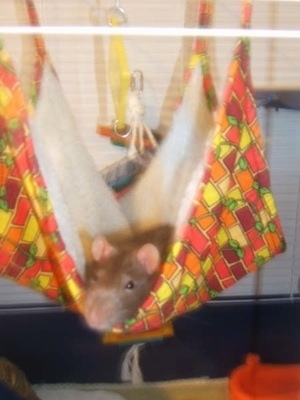
"Remmy (Sir Remmington) is a six-month-old, male VariBerk (Variegated Berkshire). He is the most outgoing and curious rat of the bunch so onto my shoulder and into my heart he went. We eat, nap, play, go for walks, and sometimes even shower together. He's a very intelligent boy but his affectionate disposition takes the cake. Remmy enjoys having his cheeks scratched, playing tag, and hand wrestling during his free ranging time. He's never shy to give me kisses, pry my mouth open, or groom my hands."
"When my alarm goes off in the morning the first thing I see is him staring at me from his hammock. Some mornings when my alarm isn't set, he waits to hear me get out of bed and throws himself against the bars. He's very confident in himself which causes me to worry about his safety more than he does. He actually tries to groom the dogs and cats! Who would have thought? Life would be boring without my squishy man rat!"
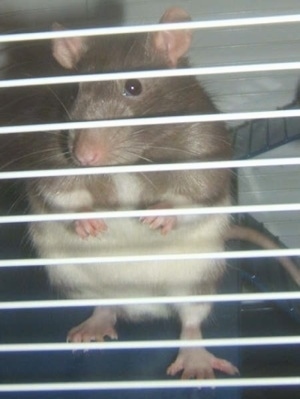
Remmy (Sir Remmington) is a six-month-old, male VariBerk (Variegated Berkshire)
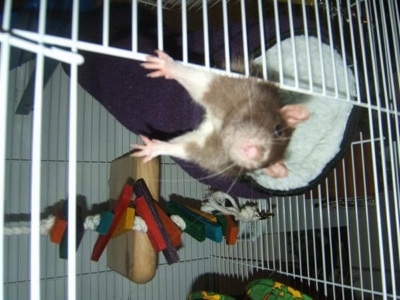
Remmy (Sir Remmington) is a six-month-old, male VariBerk (Variegated Berkshire)
"Ginger is an agouti Berkshire Dumbo Rat, and her stomach is white with a gray outline. She likes to play with people's hands, and with her sister Maully. She is 5 months old in this picture, and loves to chew the curtains through her cage bars when she thinks no one's looking. She loves to dip her head in bowls of water, but she hates getting baths. Her "husband" is my other rat, Bellatrix (but they live in separate cages!). Her favorite treat is strawberry yogies, but there is nothing that she won't eat! She also enjoys ’bobbing for frozen peas’ with Maully. She likes being a rat, but she acts more like a dog!"
Kalua, J.R. and Dixie's home which has three stories and a nest on the bottom; they love to climb up and around all the time.
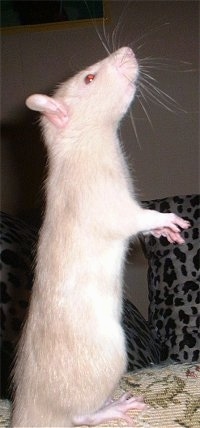
Fancy rat named OZ
Hooded rat (female, color: fawn)
Hooded rat (3 weeks old, female, color: agouti)
Hooded rats (2 weeks old, assorted colors: fawn, dove, beige)
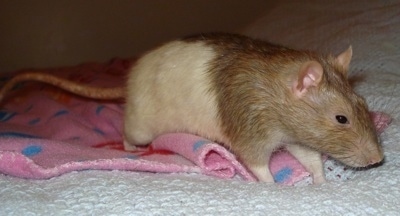
"Javier is an agouti hooded male. He's the most laid-back of rats. His favorite activity is lounging about on the couch!"
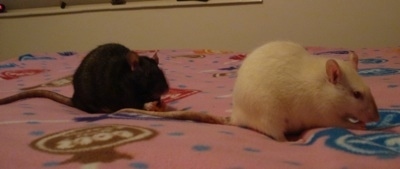
"Even though they are opposites in personality, Indie and Riot are almost inseparable. Indie is a little stubborn black Berkshire and Riot is a Himalayan that absolutely loves playing."
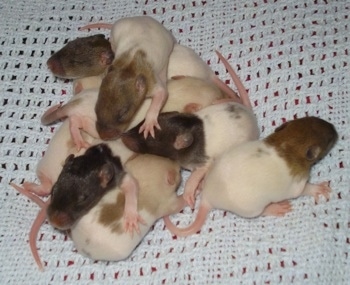
"Riot and Javier's first litter at 12 days old; there are eight total, all of them hooded."